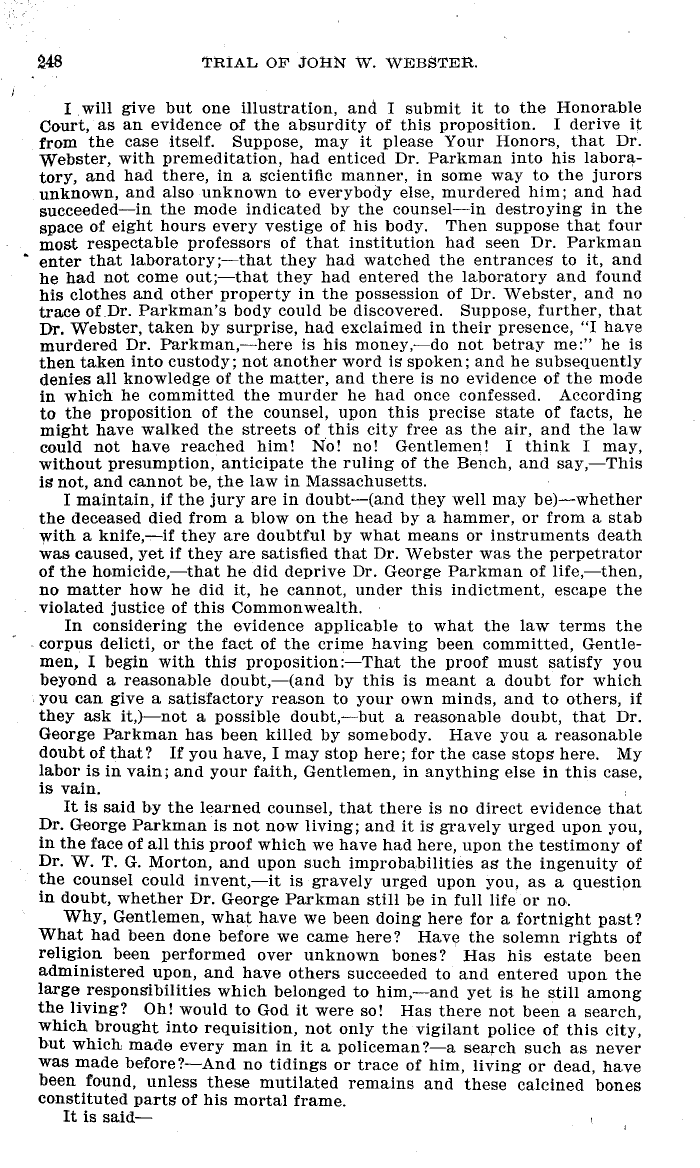|
248 TRIAL OTC' JOIAN W. WEBSTER.
I will give but one illustration, and I submit it to the Honorable
Court, as an evidence of the absurdity of this proposition. I derive it
from the case itself. Suppose, may it please Your Honors, that Dr.
Webster, with premeditation, had enticed Dr. Parkman into his labora-
tory, and had there, in a scientific manner, in some way to the jurors
unknown, and also unknown to everybody else, murdered him; and had
succeeded-in the mode indicated by the counsel-in destroying in the
space of eight hours every vestige of his body. Then suppose that four
most respectable professors of that institution had seen Dr. Parkman
enter that laboratory; that they had watched the entrances to it, and
he had not come out; that they had entered the laboratory and found
his clothes and other property in the possession of Dr. Webster, and no
trace of.Dr. Parkman's body could be discovered. Suppose, further, that
Dr. Webster, taken by surprise, had exclaimed in their presence, "I have
murdered Dr. Parkman, here is his money,-do not betray me:" he is
then taken into custody; not another word is spoken; and he subsequently
denies all knowledge of the matter, and there is no evidence of the mode
in which he committed the murder he had once confessed. According
to the proposition of the counsel, upon this precise state of facts, he
might have walked the streets of this city free as the air, and the law
could not have reached him! No! no! Gentlemen! I think I may,
without presumption, anticipate the ruling of the Bench, and say,-This
is not, and cannot be, the law in Massachusetts.
I maintain, if the jury are in doubt-(and they well may be)-whether
the deceased died from a blow on the head by a, hammer, or from a stab
with a knife, if they are doubtful by what means or instruments death
was caused, yet if they are satisfied that Dr. Webster was the perpetrator
of the homicide, that he did deprive Dr. George Parkman of life,-then,
no matter how he did it, he cannot, under this indictment, escape the
violated justice of this Commonwealth.
In considering the evidence applicable to what the law terms the
corpus delicti, or the fact of the crime having been committed, Gentle-
men, I begin with this proposition: That the proof must satisfy you
beyond a reasonable doubt,-(and by this is meant a doubt for which
you can give a satisfactory reason to your own minds, and to others, if
they ask it,)-not a possible doubt,-but a reasonable doubt, that Dr.
George Parkman has been killed by somebody. Have you a reasonable
doubt of that? If you have, I may stop here; for the case stops here. My
labor is in vain; and your faith, Gentlemen, in anything else in this case,
is vain.
It is said by the learned counsel, that there is no direct evidence that
Dr. George Parkman is not now living; and it is gravely urged upon you,
in the face of all this proof which we have had here, upon the testimony of
Dr. W. T. G. Morton, and upon such improbabilities as the ingenuity of
the counsel could invent,-it is gravely urged upon you, as a question
in doubt, whether Dr. George Parkman still be in full life or no.
Why, Gentlemen, what have we been doing here for a fortnight past?
What had been done before we came here? Have the solemn rights of
religion been performed over unknown bones? Has his estate been
administered upon, and have others succeeded to and entered upon the
large responsibilities which belonged to him,-and yet is he still among
the living? Oh! would to God it were so! Has there not been a search,
which brought into requisition, not only the vigilant police of this city,
but which made every man in it a policeman?-a search such as never
was made before?-And no tidings or trace of him, living or dead, have
been found, unless these mutilated remains and these calcined bones
constituted parts of his mortal frame.
It is said-
|

